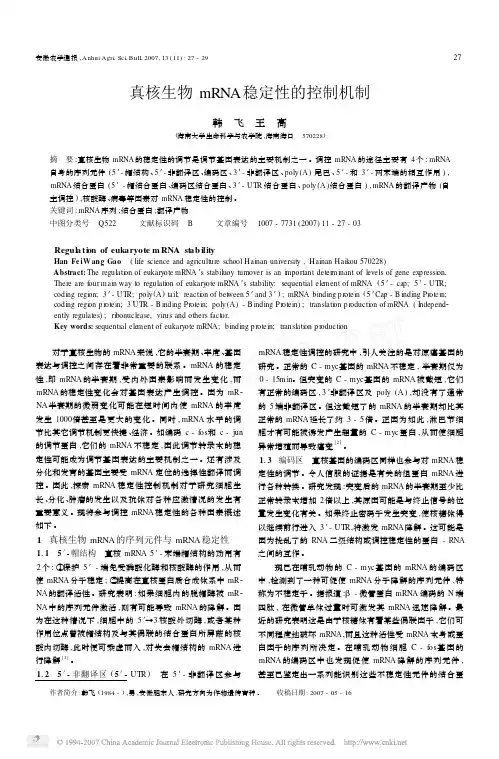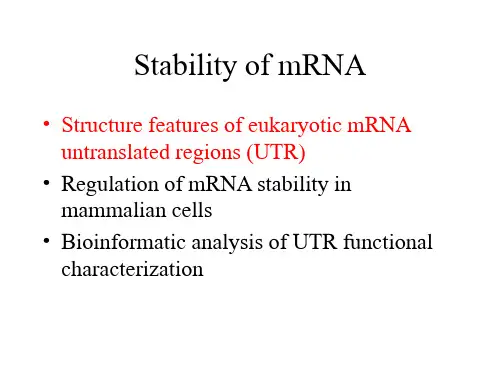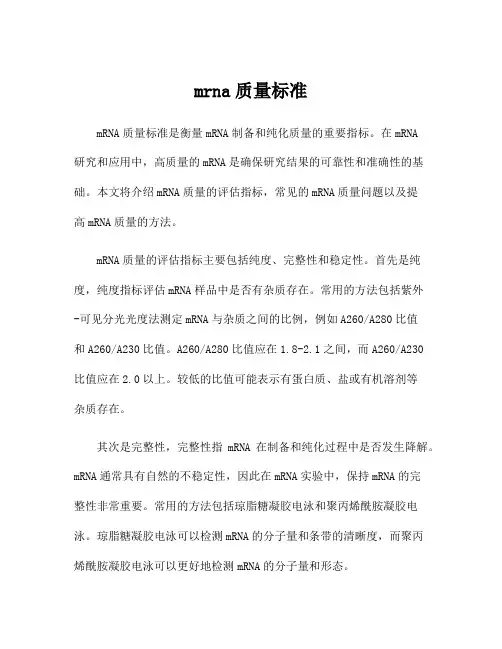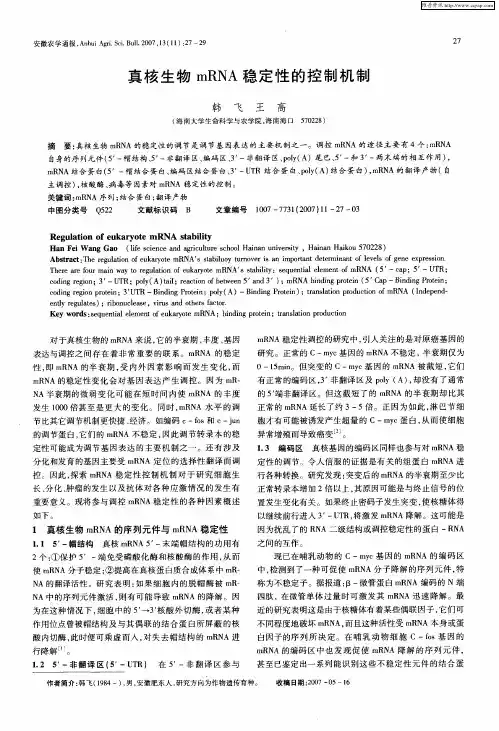mRNAstability
真核生物mRNA稳定性的控制机制

真核生物mRNA稳定性的控制机制韩 飞 王 高(海南大学生命科学与农学院,海南海口 570228)摘 要:真核生物mRNA的稳定性的调节是调节基因表达的主要机制之一。
调控mRNA的途径主要有4个:mRNA 自身的序列元件(5′-帽结构、5′-非翻译区、编码区、3′-非翻译区、poly(A)尾巴、5′-和3′-两末端的相互作用), mRNA结合蛋白(5′-帽结合蛋白、编码区结合蛋白、3′-UTR结合蛋白、poly(A)结合蛋白),mRNA的翻译产物(自主调控),核酸酶、病毒等因素对mRNA稳定性的控制。
关键词:mRNA序列;结合蛋白;翻译产物中图分类号 Q522 文献标识码 B 文章编号 1007-7731(2007)11-27-03Regul a ti on of eukaryote m RNA st ab ilityHan Fe iW ang Gao (life science and agriculture school Hainan university,Hainan Haikou570228)Abstract:The regulati on of eukaryote mRNA′s stabiluoy turnover is an i m portant deter m inant of levels of gene exp ressi on1 There are four main way t o regulati on of eukaryote mRNA′s stability:sequential ele ment of mRNA(5′-cap;5′-UTR; coding regi on;3′-UTR;poly(A)tail;reacti on of bet w een5′and3′);mRNA binding p r otein(5′Cap-B inding Pr otein; coding regi on p r otein;3′UTR-B inding Pr otein;poly(A)-B inding Pr otein);translati on p r oducti on of mRNA(I ndepend2 ently regulates);ribonuclease,virus and others fact or1Key words:sequential ele ment of eukaryote mRNA;binding p r otein;translati on p r oducti on 对于真核生物的mRNA来说,它的半衰期、丰度、基因表达与调控之间存在着非常重要的联系。
mRNAstability

Furuichi & colleagues, 1977
Labeled reovirus RNAs w/ capped (green), blocked (blue) or decapped (red) 5’-end a) glycerol gradient centrifugation (ggc) b) incubation in X. oocyte, 8 h > ggc c) decapped & deblocked RNAs (b-elimination yielding pppGm & pppG) + incubation in X. oocyte, 8 h > ggc d) as (b) but incubation in wheat germ extract
Most mammalian mRNAs are polyadenylated!
mRNA Decay and Translation
The intimate relationship between mRNA decay and translation is further indicated by the ability of translation-initiation factors (eIF) and proteins (PAB) that bind the poly(A) tail to protect the mRNA from degradation. Moreover, evidence shows that inhibiting translation elongation promotes mRNA stabilization.
w/o w/
Elements in the 3’ UTR
RNA结合蛋白与转录后调控

RNA结合蛋白与转录后调控 结合蛋白与转录后调控
王文恭
DNA and chromatin levels
Gene Regulation
Transcription level Maturation mRNA export Post-transcriptional level mRNA turnover Translation level Post-translation level
HuR
Hel-N1 HuD TTP
BRF1 TIA-1 KSRP
CUG-BP2 Nucleolin TINO PAIP2
c-myc (46) c-myc (42) c-fos (42,67) c-fos (53) PTH (56) p21 (48) GM–CSF (42) Cyclin D1 (48) TNF-alpha (42) GM–CSF (53,54) IL-3 (55) c-fos(59,63,67) p53(99,137) TNF-alpha (139) MyoD (68) Cox-2 (139) p21 (48,68,69) Cyclin A (70) Cyclin B1 (70) Cyclin D1 (48) NOS II/iNOS (64) GM–CSF (59) TNF-alpha (65,74,139) Cox-2 (71,139) IL-3 (55,66) VEGF (62) Myogenin (68) NF-M (73) TNF-alpha (74) GLUT1 (72) GLUT1 (72) GAP-43 (75–77) c-fos (90) GM–CSF (18,81,83–85,91) TNF-alpha (18,81,83–86,89,90) Cox-2 (87) IL-2 (82,90) IL-3 (18,66,83,84,88) TNF-alpha (89,93) IL-3 (55,92,93) TNF-alpha (120) Cox-2 (121) c-fos (90,93) NOS II/iNOS (102) TNF-alpha (90,93) IL-2 (90,93) c-jun (93) Cox-2 (150) Cox-2 (150) bcl-2 (175) bcl-2 (176) VEGF (177)
mrna质量标准

mrna质量标准mRNA质量标准是衡量mRNA制备和纯化质量的重要指标。
在mRNA研究和应用中,高质量的mRNA是确保研究结果的可靠性和准确性的基础。
本文将介绍mRNA质量的评估指标,常见的mRNA质量问题以及提高mRNA质量的方法。
mRNA质量的评估指标主要包括纯度、完整性和稳定性。
首先是纯度,纯度指标评估mRNA样品中是否有杂质存在。
常用的方法包括紫外-可见分光光度法测定mRNA与杂质之间的比例,例如A260/A280比值和A260/A230比值。
A260/A280比值应在1.8-2.1之间,而A260/A230比值应在2.0以上。
较低的比值可能表示有蛋白质、盐或有机溶剂等杂质存在。
其次是完整性,完整性指mRNA在制备和纯化过程中是否发生降解。
mRNA通常具有自然的不稳定性,因此在mRNA实验中,保持mRNA的完整性非常重要。
常用的方法包括琼脂糖凝胶电泳和聚丙烯酰胺凝胶电泳。
琼脂糖凝胶电泳可以检测mRNA的分子量和条带的清晰度,而聚丙烯酰胺凝胶电泳可以更好地检测mRNA的分子量和形态。
最后是稳定性,稳定性指mRNA的保持时间和储存条件。
mRNA在环境中很容易被降解,因此适当的储存条件可以延长mRNA的寿命。
常见的存储条件包括-80°C冻存和使用RNase抑制剂。
此外,也可以通过超滤或柱子纯化等方法去除余留的RNase,提高mRNA的稳定性。
在mRNA制备和纯化过程中,常见的mRNA质量问题包括降解、污染和重组RNA的产生。
mRNA降解可能是由于制备过程中使用的酶或未恰当的储存条件导致的。
mRNA的纯化过程中可能存在DNA、RNA残留物或其他污染物,这些污染物可能会干扰后续的实验结果。
另外,某些反应条件下,如高温反应,可能会促使mRNA重组,导致产生不完整的RNA序列。
为了提高mRNA的质量,一些关键的方法和步骤可以被采用。
首先,选择合适的mRNA制备和纯化试剂和仪器。
质量可靠的试剂和仪器可以减少制备和纯化过程中的污染和降解。
mRNA稳定性与基因表达

二、原核生物中mRNA稳定性与基因表达
Csr AB是大肠杆菌中的一个调节系统,CsrA是 一个RNA结合蛋白,CsrB是一个非编码RNA分子。 一般条件下CsrA结合到CsrB分子上,调控表达 时,CsrA从CsrB上脱落,结合在受调控的mRNA 分子上,通过改变mRNA的二级结构,使得其变 成易受核酸酶攻击的不稳定构象,最终被降解。 静止期细菌细胞糖原的储存和生长期糖酵解途 径消耗糖原的平衡便是由Csr AB系统调节。
而mRNA分子降解的可能性主要取决于他们的二 级结构。
inhibit
DNA
feedback
RNA聚合酶/转 录复合物
识别蛋白
protein
inhibit
mRNA
RNase/ PNPase/ RNA helicase
mRNA degradation
Figure1 mRNA稳定性调节模型图
PNPase: exonuclease polynucleotide phosphorylase
铁浓较低
不能起始翻译
稳定性高 不降解
铁浓度较高 起始翻译 稳定性低 降解
csrA-csrB 复合体
glg mRNA
csrA
核酸酶
glg mRNA降解
glg mRNA不能作为模版翻译
三、真核生物中mRNA稳定性与基因表达
真核生物中,转铁蛋白受体(TfR)负责铁摄取, 铁蛋白负责铁解毒。在转铁蛋白受体和铁蛋白 mRNA上存在相似的铁应答元件(iron responsive element,IRE),IRE与IRE结合蛋 白(IRP)之间的相互作用控制了两个mRNA的翻 译效率。 其中,铁蛋白中,IRE和IRP的相互作用促使 mRNA构象改变,无法起始铁蛋白mRNA的翻译。 在转铁蛋白受体中,IRE和IRP的相互作用使得 mRNA变得更加的稳定,不易受到细胞中核酸酶 的攻击,可以稳定的翻译出新的蛋白质。
真核生物mRNA稳定性的控制机制

节 比其 它调节机 制更快 捷 、 经济 。如编码 C l 和 C jn —o s — u 的调节 蛋 白, 它们 的 m N R A不 稳定 , 因此 调 节转 录 本 的稳
定性可 能成 为调节 基 因表 达 的 主要 机 制之 一 。还 有涉 及 分化 和发 育 的基 因主要 受 mR A定 位 的选 择性 翻译 而调 N
mN R A的稳定 性变 化 会 对基 因表 达 产 生调 控 。 因 为 m ・ R N A半 衰期 的微 弱变 化可 能 在短 时 间 内使 mR A 的 丰度 N 发 生 10 0 0倍甚 至是 更 大 的 变化 。同 时 , N 水 平 的调 mR A
0 5 i。但 突变 的 C—m c 因 的 m N —1mn y基 R A被 截短 , 们 它
R e ul to f e a y t RN A t biiy g a i n o uk r o e m sa l t
Ha e W a gG o (i c n eadar utr sho H ia nvrt nF i n a 1esi c n gi l e col a nu i sy,H i nH i u5 0 2 ) f e c u n ei a a a o 72 8 n k
主调控) 核 酸酶 、 毒等因素对 mR A稳 定性的控制 。 , 病 N
关 键 词 : R A序 列 ; m N 结合 蛋 白 ; 译 产 物 翻 中图 分 类 号 Q 2 52 文献标识码 B 文章编号 10 7 3 (0 7 l 一 7— 3 0 7— 7 l 20 ) l 2 0
cdn g n 3 oigr i ; 一U R; o ( ti rat no e en5 n ; R Abn i rt n( C p—Bn igPo i; eo T pl A)a ; eci f t e y l o bw ad3 ) m N idn poe 5 a g i id rt n n e cdn g npo i; T oigr i r e 3U R—BnigPo i;pl( eo tn idn rtn o A)一Bn igPo i) t nltnpout no mR A (n eed e y id r e ; r s i rd co f N Id pn・ n tn a ao i
mRNA稳定性和细胞内定位
FIGURE 06: The major deadenylation-dependent decay pathways in eukaryotes
22.5 Most Eukaryotic mRNA is Degraded via Two Deadenylation-Dependent Pathways
22.4 Prokaryotic mRNA Degradation Involves Multiple Enzymes
• Degradation of bacterial mRNAs is initiated by removal of a pyrophosphate from the 5′ terminus. • Monophosphorylated mRNAs are degraded during translation in a twostep cycle involving endonucleolytic cleavages, followed by 3′ to 5′ digestion of the resulting fragments.
– It does not use a template.
22.4 Prokaryotic mRNA Involves Multiple Enzymes
• poly(A) – A stretch of adenylic acid that is added to the 3′ end of mRNA following its synthesis. • The main degradation enzymes work as a complex called the degradosome.
22.5 Most Eukaryotic mRNA is Degraded via Two Deadenylation-Dependent Pathways
名词简答整理
增强子:是指能使与它连锁的基因转录频率明显增加的DNA序列。
它可以在启动子的上游,也可以在启动子的下游,绝大多数增强子具有组织特异性。
Operon:是细菌基因表达调控的一个完整单元,包含结构基因以及能够被调节基因产物所识别并结合的顺式作用元件。
朊病毒:是一种无免疫原性但能在细胞内复制、并能侵染动物的疏水性蛋白质。
致病途径具有自发性、遗传性和传染性三个特征。
C值矛盾:生物体进化程度高低与大C值不成明显相关(非线性);亲缘关系相近的生物大C值相差较大;一种生物内大C值与小c值相差极大。
RNAi:是由外源双链RNA产生的21~25nt小的干涉RNA而触发内生同源mRNA降解的过程,是一种转录后水平上的基因沉默机制。
RNA编辑:RNA编辑是指由RNA水平的核苷酸改变所引起的密码子发生变化的一种预定修饰,一种RNA编辑是以另一RNA为模板来修饰mRNA前体。
通过编辑,可以给mRNA前体添加新的遗传信息。
移码突变:由于缺失或插入而导致突变位点以后的三联体密码可读矿改变。
Transcription:是指以DNA为模板,在依赖于DNA的RNA聚合酶的催化下,以4种NTP(A TP、CTP、GTP和UTP)为原料,合成RNA的过程。
顺式作用元件:是指DNA上对基因表达有调节活性的某些特定的调控序列,其活性仅影响与其自身处于同一DNA分子上的基因。
分子伴侣:是结合其他不稳定蛋白质并稳定其构象的一类蛋白质。
通过与部分折叠的多肽协调性地结合与释放,分子伴侣促进了包括蛋白质折叠、寡聚体装配、亚细胞定位和蛋白质降解等多个过程。
转座子:是染色体或质粒上的一段独立的DNA序列,作为一个可以重组但不交换的遗传单元,能在原位保留其本身的情况下,从一个位点转移到另一个位点。
DNA复杂度:是DNA分子中无重复的核苷酸序列的最大长度。
负调控:阻遏蛋白结合在操作子位点,阻止基因的表达。
没有调节蛋白时操纵元内结构基因是表达的,而加入调节蛋白后结构基因的表达活性被关闭,这种调节称为负调节。
mRNA稳定性和细胞内定位
22.4 Prokaryotic mRNA Degradation Involves Multiple Enzymes
• poly(A) – A stretch of adenylic acid that is added to the 3′ end of mRNA following its synthesis. • The main degradation enzymes work as a complex called the degradosome.
– Both are variable in size.
22.2 Messenger RNAs Are Unstable Molecules
• mRNA instability is due to the action of ribonucleases. • Ribonucleases differ in their substrate preference and mode of attack. • endoribonuclease – A ribonuclease that cleaves an RNA at an internal site(s). • exoribonuclease – A ribonuclease that removes terminal ribonucleotides from RNA.
FIGURE 05: Degradation of bacterial mRNAs
22.4 Prokaryotic mRNA Degradation Involves Multiple Enzymes
• 3′ polyadenylation can facilitate the degradation of mRNA fragments containing secondary structure. • poly(A) polymerase (PAP) – The enzyme that adds the stretch of polyadenylic acid to the 3′ end of eukaryotic mRNA.
翻译调控mRNA稳定性和速度
翻译调控mRNA稳定性和速度随着基因组学的发展,我们对于基因调控的认识越来越深入。
mRNA是基因转录的产物,但是它并不是立即被翻译成蛋白质的。
在细胞中,mRNA的稳定性和速度会影响到蛋白质合成的效率和数量。
因此,研究如何翻译调控mRNA的稳定性和速度变得越来越重要。
IRES与5'UTR5'UTR(5'非翻译区)是mRNA中的一个结构。
它在翻译过程中并没有直接产生蛋白质,而是通过调节到达蛋白翻译的速度来影响细胞中蛋白质的合成。
IRES(internal ribosome entry site)是5'UTR中一个特别的序列,它可以在5'端没有5'帽子的mRNA中招募核糖体,并促进翻译的开展。
因此,IRES序列的特点可以影响5'UTR对mRNA翻译的调控。
mRNA的稳定性mRNA的稳定性是指mRNA在细胞内的降解速度。
mRNA的稳定性会影响到细胞中翻译mRNA表达的数量。
mRNA稳定性通常受到转录后调控元件(TE,transcriptional regulatory element)的调控。
这些TE包括启动子、强化子和转录因子的结合位点。
当转录因子结合在TE上时,它们可以增加或减少mRNA的稳定性。
此外,mRNA自身的结构也可以影响到它的稳定性。
例如,如果mRNA中有结晶的序列,它们可以降低mRNA的稳定性。
3'UTR调控3'UTR是mRNA的另一个结构,它位于剪切信号后面。
3'UTR中的序列和结构对翻译的效率和mRNA的稳定性都有影响。
在3'UTR中,有一类序列被称为ARE(AU-rich element),这类序列可以通过调控RNA酶的结构来影响mRNA的稳定性。
此外,3'UTR中的序列也可以影响到mRNA的翻译速度,例如与泛素化相关的序列。
总结mRNA的稳定性和速度对蛋白质表达来说非常重要。
研究表明,IRES、5'UTR、转录后调控元件、mRNA序列和3'UTR都可以影响到mRNA的稳定性和速度。
- 1、下载文档前请自行甄别文档内容的完整性,平台不提供额外的编辑、内容补充、找答案等附加服务。
- 2、"仅部分预览"的文档,不可在线预览部分如存在完整性等问题,可反馈申请退款(可完整预览的文档不适用该条件!)。
- 3、如文档侵犯您的权益,请联系客服反馈,我们会尽快为您处理(人工客服工作时间:9:00-18:30)。
poly(A) synthesis
aided by PAB II (yellow)
Darnell & colleagues, 1973
Poly(A): nuclear form 210 nt, cytoplasmic form 190 nt > poly(A) undergoes considerable shortening in the cytoplasm
Significance of mRNA Stability
Controlling the rate at which the mRNA decays can regulate the levels of cellular messenger RNA transcripts. Because decay rates affect the expression of specific genes, they provide a cell with flexibility in effecting rapid change.
Furuichi & colleagues, 1977
Labeled reovirus RNAs w/ capped (green), blocked (blue) or decapped (red) 5’-end a) glycerol gradient centrifugation (ggc) b) incubation in X. oocyte, 8 h > ggc c) decapped & deblocked RNAs (b-elimination yielding pppGm & pppG) + incubation in X. oocyte, 8 h > ggc d) as (b) but incubation in wheat germ extract
Most mammalian mRNAs are polyadenylated!
mRNA Decay and Translation
The intimate relationship between mRNA decay and translation is further indicated by the ability of translation-initiation factors (eIF) and proteins (PAB) that bind the poly(A) tail to protect the mRNA from degradation. Moreover, evidence shows that inhibiting translation elongation promotes mRNA stabilization.
Stability of mRNA
• Structure features of eukaryotic mRNA untranslated regions (UTR) • Regulation of mRNA stability in mammalian cells • Bioinformatic analysis of UTR functional characterization
Elements in the 5’ UTR
7-methylguanosine cap
Caps provide at least four functions:
• Protection of mRNA from degradation (see example)
• Enhancement of mRNA’s translatability • Transport of mRNA out of nucleus • Proper splicing of pre-mRNA
CPSF: blue CstF: brown CF I & II: grey
cleavage
stimulated by pol II CTD CstF & CFs leaves PAP (orange) enters
oligo(A) synthesis
aided by CPSF
Cytoplasmic polyadenylation elements (CPE) & binding proteins
What are the sequence elements and factors that control the half-lives of mRNAs?
General Structure of a Eukaryotic mRNA
illustrating some post-transcriptional regulatory elements for gene expression and their activity. 5’UTR mediated regulation may involve: the 7-methyl-guanine (cap); hairpin-like secondary structure; RNA-protein interactions; upstream open reading frames (uORFs); internal ribosome entry sites (IRES). 3’UTR mediated regulation may involve: antisense RNA interactions; RNA-protein interactions, involving also multiprotein complexes; cytoplasmic polyadenylation elements (CPE); poly(A) tail and variation of its size.
In eukaryotes: the 3’ poly(A) tail confers stability. In bacteria: a hairpin structure in mRNA with
r-independent terminator confers stability.
Moreover, many clinically relevant mRNAs-including several encoding cytokines, growth factors and proto-oncogenes--are regulated by differential RNA stability.
mRNA abundance is determined by balancing transcription and RNA decay. mRNA stability can be rapidly modulated to alter the expression of specific genes thereby providing flexibility in affecting changes in patterns of protein synthesis.
When the poly(A) is gone, the mRNA is slated for destruction
Stability of mRNA
• Structure features of eukaryotic mRNA untranslated regions (UTR) • Regulation of mRNA stability in mammalian cells • Bioinformatic analysis of UTR functional characterization
w/o w/
Elements in the 3’ UTR
• AU-rich element (ARE) and proteins that bind AREs • Iron-responsive element (IRE) and iron regulatory protein (IRP) • Cell cycle-regulated histone mRNA stemloop determinant (SL/SLBP) • Cytoplasmic polyadenylation element (CPE)……
Translation initiation complex
What is the rate-limiting step in mRNA degradation?
An evolutionarily conserved mRNAdegradation pathway is initiated by the removal of the 3’- poly(A) tail. This disrupts the translation initiation complex and provides degradative enzymes with access to the 5’ cap and remaining RNA body.
Transferrin receptor mRNA ion-responsive element & IRP
PNAS 93: 8179-8182, 1996
Histone mRNA stem loop determinant & SLBP
Gene 239: 1-14, 1999
assembly
Nuclear
cytoplasmic
5S rRNA
Cytoplasmic polyadenylation of maternal mRNAs
The best studied cases are those that occur during oocyte maturation
Maturation-specific polyadenylation of Xenopus maternal mRNAs in the cytoplasm depends on two sequence motifs: The AAUAAA motif & an upstream motif with UUUUUAU or a closely related sequence
